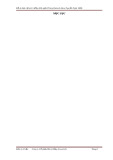
BioMed Central
Page 1 of 11
(page number not for citation purposes)
Journal of Immune Based Therapies
and Vaccines
Open Access
Original research
Kinetics and isotype profile of antibody responses in rhesus
macaques induced following vaccination with HPV 6, 11, 16 and 18
L1-virus-like particles formulated with or without Merck aluminum
adjuvant
Wanda Ruiz1, William L McClements2, Kathrin U Jansen2 and Mark T Esser*1
Address: 1Vaccine and Biologics Research Merck Research Laboratories 466 Devon Park Dr. Wayne, PA 19087-8630 USA and 2Vaccine and
Biologics Research Merck Research Laboratories West Point, PA 19486 USA
Email: Wanda Ruiz - wanda_ruiz@merck.com; William L McClements - william_mcclements@merck.com;
Kathrin U Jansen - jansen@mac.com; Mark T Esser* - mark_esser@merck.com
* Corresponding author
human papillomavirusvaccineneutralizing antibodyLuminex
Abstract
Background: Human papillomaviruses (HPV) are the most common sexually transmitted viruses.
Infection of the cervical epithelium by HPVs can lead to the development of cervical cancer. Recent
advances in vaccine research have shown that immunization with papillomavirus-like particles
(VLPs) containing the major structural viral protein, L1 from HPV 16 can provide protection from
the establishment of a chronic HPV 16 infection and related cervical intraepithelial neoplasia (CIN)
in baseline HPV 16 naïve women.
Methods: To better understand the quantitative and qualitative effects of aluminum adjuvant on
the immunogenic properties of an HPV 6, 11, 16 and 18L1 VLP vaccine, we used an HPV-specific,
antibody isotyping assay and a competitive immunoassay that measures antibodies to neutralizing
epitopes to profile sera from rhesus macaques immunized with the HPV L1 VLP vaccine formulated
with or without aluminum adjuvant.
Results: Immunization with VLPs formulated with the aluminum adjuvant elicited a significantly
stronger immune response with higher peak antibody titers both at four weeks post vaccination
(12.7 to 41.9-fold higher) as well as in the persistent phase at week 52 (4.3 to 26.7-fold higher) than
that of VLPs alone. Furthermore, the aluminum adjuvant formulated HPV VLP vaccine elicited a
predominantly T helper type 2 response, with high levels of IgG1 and IgG4 and low levels of IgG2.
The vaccine also elicited high levels of serum IgA, which may be important in providing mucosal
immunity to impart protection in the anogenital tract.
Conclusion: These results show that the HPV 6, 11, 16 and 18 L1-VLP vaccine formulated with
Merck aluminum adjuvant elicits a robust and durable immune response and holds promise as a
vaccine for preventing cervical cancer.
Published: 20 April 2005
Journal of Immune Based Therapies and Vaccines 2005, 3:2 doi:10.1186/1476-8518-3-2
Received: 03 March 2005
Accepted: 20 April 2005
This article is available from: http://www.jibtherapies.com/content/3/1/2
© 2005 Ruiz et al; licensee BioMed Central Ltd.
This is an Open Access article distributed under the terms of the Creative Commons Attribution License (http://creativecommons.org/licenses/by/2.0),
which permits unrestricted use, distribution, and reproduction in any medium, provided the original work is properly cited.

Journal of Immune Based Therapies and Vaccines 2005, 3:2 http://www.jibtherapies.com/content/3/1/2
Page 2 of 11
(page number not for citation purposes)
Background
Cervical cancer remains a leading cause of cancer-related
deaths in women. HPV infection is the obligate first step
in the development of cervical cancer [1]. Nearly a quarter
of a million women die from cervical cancer and about
half a million are diagnosed with this disease each year
[2]. Cervical cancer accounts for 12% of all cancers in
women and is the second most frequent gynecological
malignancy in the world [3]. A large portion of this health
burden is in the developing world, where women do not
have access to good healthcare and Papanicolaou (Pap)
screens. Although the widespread use of Pap screening in
the developed world has increased the early detection of
cervical dysplasia and cancer, thereby improving treat-
ment outcomes for cervical cancer, it would be far more
preferable to have a vaccine that blocks HPV infection,
thereby preventing initiation of the disease process. Also,
developing countries that usually do not have access to
Pap screening and other preventive measures would fur-
ther benefit from a vaccine that blocks HPV infection and
its subsequent disease consequences. Therefore, there is a
great need for an effective and generally well-tolerated
HPV vaccine, having a low rate of occurrence of adverse
events during administration.
Human papillomaviruses are small double-stranded DNA
viruses. Infection with HPV is the most common viral sex-
ually transmitted diseases worldwide [4]. HPV infects
cutaneous and mucosal epithelial cells and causes benign
and malignant hyperproliferative lesions, which includes
genital warts and cervical cancer [5]. To date, more than
100 HPV types have been identified. Of these, 35 infect
the genital tract [6,7]. Genital HPV types can be divided
into two broad categories: low-risk types which cause gen-
ital warts, cervical dysplasia, but little cancer, and high-
risk types, which cause dysplasia that can progress to can-
cer. HPV type 16 and 18 infection cause 70% of cancer
cases and 25% of low grade cervical dysplasia [8]. HPV
types 6 and 11, on the other hand, cause approximately
95% of genital warts (condylomata acuminata or venereal
warts) and 25% of low grade cervical dysplasia (CIN1)
[9,10]. Thus, a vaccine targeting HPV 6, 11, 16 and 18 will
target the majority of HPV-related clinical disease.
Recently, we reported a proof-of-concept efficacy study for
a prophylactic vaccine composed of HPV 16 L1 virus-like
particles (VLP) formulated on Merck Aluminum Adjuvant
(MAA) [11]. The double-blinded study randomized 2,391
women (16–23 years old) to receive either placebo or
three doses of 40 µg of the HPV 16 VLPs in a 0, 2, and 6
month regimen. The primary efficacy endpoint was per-
sistent HPV 16 infection, including HPV 16 related cervi-
cal dysplasia. Since the vaccine is being developed for
prophylaxis against infection, the primary analysis was
conducted in women who were naïve to HPV 16 at enroll-
ment and remained free of HPV 16 infection through the
completion of the vaccination series. Among placebo
recipients within this cohort, 41 cases of persistent HPV
16 infection were detected. None of the women who
received HPV 16 L1 VLP vaccine in this cohort developed
an endpoint case [11].
Currently, we are investigating a quadrivalent vaccine,
composed of HPV 6, 11, 16, and 18 L1 VLPs formulated
with MAA. This vaccine has also been shown to be effec-
tive in preventing persistent infection and HPV 6, 11, 16
and 18 related cervical dysplasia [12]. To better under-
stand the quantitative and qualitative effects of Merck alu-
minum adjuvant on the immunogenicity of the VLPs we
used a novel HPV type-specific, antibody isotyping assay
and a competitive Luminex immunoassay (cLIA) to meas-
ure HPV type-specific antibody responses in rhesus
macaques. The results presented here show that formula-
tion with Merck aluminum adjuvant increased the VLP's
immunogenicity without affecting the isotype profile.
Methods
Vaccines
Virus-like particles were prepared as previously described
(with modifications) from individual lysates of types- Sac-
charomyces cerevisiae expressing the L1 genes of HPV 6, 11,
16 and 18, respectively [13]. Equal concentrations of all
four HPV VLPs were combined and used either directly, or
adsorbed to MAA. A standard vaccine dose was composed
of 2 µg each of the four VLP types, with or without 225 µg
of MAA. The Merck Aluminum Adjuvant is a proprietary
aluminum hydroxyphosphate sulfate based adjuvant used
in other vaccines manufactured by Merck & Co., [14].
Vaccine study on Rhesus Macaques
Groups of male and female Rhesus macaque (n = 5) were
immunized at weeks 0, 8 and 24 with the two experimen-
tal vaccines described above. Serum was collected at weeks
0, 2, 4, 8, 10, 12, 16, 20, 24, 26, 28 and 52. The animals
were maintained in accordance with the Institutional Ani-
mal Care and Use Committees of Merck Research Labora-
tories (West Point, PA).
Antibodies
The monoclonal antibodies used in the HPV cLIA
included H6.M48 [15] for HPV 6, K11.B2 for HPV 11,
H16.V5 [16] for HPV 16 and H18.J4 [16] for HPV 18.
These antibodies have been shown to be HPV type-spe-
cific and to bind to neutralizing epitopes [17]. The mAbs
were conjugated to phycoerythrin (Chromaprobe, Aptos,
CA) and used at a final concentration of 0.1 µg/mL each.
HPV-specific immunoglobulin isotyping assay
A multiplexed antibody isotyping Luminex assay was
developed to characterize the qualitative aspects of the

Journal of Immune Based Therapies and Vaccines 2005, 3:2 http://www.jibtherapies.com/content/3/1/2
Page 3 of 11
(page number not for citation purposes)
HPV-specific humoral immune response. The multi-
plexed, isotyping assay was used to classify HPV-specific
antibodies as IgM, IgA, IgE, IgG1, IgG2, IgG4, or total IgG.
IgG3 was not evaluated since rhesus macaques do not
make the IgG3 subclass of antibodies [18,19]. A panel of
isotype-specific monoclonal antibodies to IgE, IgG1,
IgG2, and IgG4 were purchased from either Sigma (St.
Louis, MO) or Southern Biotechnology (Birmingham, AL)
and isotype-specific polyclonal antibodies to IgA, IgM,
and total IgG were purchased from Rockland Inc. (Gil-
bertsville, PA). These antibodies (Table 1) were evaluated
for reactivity to human, rhesus and African green monkey
immunoglobulins. Specificity of the antibodies to their
respective immunoglobulin isotypes was established by a
Luminex assay using purified human IgM, IgA, IgE, IgG1,
IgG2, IgG3 and IgG4 covalently conjugated to Luminex
microspheres. Microspheres were incubated overnight
with Antibody Depleted Human Serum (ADHS), washed
and detected using the isotype specific antibodies at the
concentrations shown in Table 1. Optimum antibody
concentrations, shown in Table 1, were established by
comparing differing concentrations of the detection Abs
in titrations of sera prior to immunization and positive
sera from HPV 6, 11, 16 and 18L1 VLP vaccinated African
green monkeys. Ab concentrations were chosen that gave
the most sensitivity and the greatest signal to noise ratio
between pre-immune and sera from vaccinated animals.
Cross-reactivity between isotype detection antibodies was
examined by conjugating purified human Igs to Luminex
microspheres and incubating these microspheres with
each of the isotyping antibodies at their chosen assay con-
centrations. In these experiments we detected some cross-
reactivity of the anti IgG1 MAb towards IgG2 (71%) and
the anti IgG2 towards IgG1 (58%). This cross-reactivity
was the rationale for decreasing the concentration of the
anti-IgG1 and IgG2 MAbs to 10 µg/mL (Table 1).
For the multiplexed, HPV-specific antibody isotyping
assay, HPV 6, 11, 16, and 18 VLPs were covalently conju-
gated to four distinct Luminex microspheres identified as
microsphere 6, 11, 16 and 18, respectively. Test sera from
vaccinated rhesus macaques were serially diluted 5-fold
starting from a dilution of 1:10 with ADHS and incubated
overnight with the VLPs conjugated to microspheres
(5,000 VLP-microspheres for each type in PBS + 1% Triton
X-100 (PBST) in a total volume of 100 µl in a 1.2 µm
hydrophilic, low protein binding, Durapore® membrane
filter plate (Millipore, Bedford, MA). The plate contents
were washed 3 times with 200 µl of PBST and resuspended
in PBST. HPV type-specific antibodies bound to the VLPs
were incubated for 2 hours with biotinylated, isotype-spe-
cific secondary detection antibodies at the concentrations
shown in Table 1. The microspheres were washed three
times, and resuspended in PBST. The biotinylated anti-
bodies were detected by incubation with streptavidin con-
jugated to phycoerythrin (Strep-PE) for 30 min at a final
concentration of 5 µg/mL. The plates were washed 3 times
and read on a Bio-plex analyzer purchased from Bio-Rad
Laboratories, Inc. (Hercules, CA). The Bio-plex analyzer,
based on Luminex xMAP technology, is a modified flow
cytometer that allows for simultaneous quantitation of up
to 100 analytes in a single well and reports Median Fluo-
rescence Intensity (MFI) signals from the Strep-PE detec-
tion reagent [20]. End-point dilution titers were defined
by comparing signals to those of ADHS, the negative con-
trol. For positivity, an MFI value had to be above the
average of ADHS + 10 standard deviations and the end-
point dilution had to demonstrate positivity at the previ-
ous lower dilution.
HPV type-specific competitive Luminex Immunoassay
(cLIA)
An optimized and previously validated HPV competitive
Luminex Immunoassay (cLIA) first described by Opalka et
Table 1: Isotype specific antibodies and streptavidin-PE used in the HPV antibody isotyping assays
Isotype Reagent Type or MAb Identity Specificity Source Supplier Concentration
Primary
IgM polyclonal Monkey IgM (mu chain specific) Goat Rockland, Gilbertsville, PA 50 µg/mL
IgA polyclonal Monkey IgA (alpha chain specific) Goat Rockland, Gilbertsville, PA 25 µg/mL
IgE HP-6029 Human IgE (epsilon chain specific) Mouse Southern Biotech,
Birmingham, AL
25 µg/mL
IgG1 HP-6091or 8c/639 Human IgG1 Mouse Sigma, St. Louis, MO 10 µg/mL
IgG2 HP-6014 Human IgG2 Mouse Sigma, St. Louis, MO 10 µg/mL
IgG4 HP-6025 Human IgG4 Mouse Sigma, St. Louis, MO 25 µg/mL
Total IgG polyclonal Monkey IgG (gamma chain specific) Goat Rockland, Gilbertsville, PA 5 µg/mL
Secondary
PE- Streptavidin NA NA NA Rockland, Gilbertsville, PA 5 µg/mL

Journal of Immune Based Therapies and Vaccines 2005, 3:2 http://www.jibtherapies.com/content/3/1/2
Page 4 of 11
(page number not for citation purposes)
al. [21] was used to quantify HPV 6, 11, 16, and 18 spe-
cific antibodies to known-neutralizing epitopes on VLPs.
Using the same VLP-conjugated microspheres described
above, antibody titers were determined using a competi-
tive format, where HPV type-specific phycoerythrin (PE)-
labeled monoclonal antibodies (MAbs) to known neu-
tralizing epitopes compete with serum antibodies for
binding to conformationally dependent, neutralizing
epitopes. The fluorescent signals from bound HPV-spe-
cific MAbs are inversely proportional to the subject's neu-
tralizing antibody titers. Relative inhibition of MAb
binding in test serum was compared to a standard refer-
ence serum using a four-parameter logistic curve fit [22].
The reference sera for HPV 6, 11, 16 and 18 used for the
standard curve were assigned arbitrary values expressed in
milli-Merck Units per milliliter (mMU/mL). An antibody
titer of >200 mMU/mL for HPV 11 has been shown to
neutralize ~108 virions in the athymic mouse xenograft
assay [23]. The titers for HPV 6 and 11 reference sera were
previously determined in a pseudoneutralization assay
[17]. The lower limit of quantitation for HPV6, 11 and 18
cLIAs is 8 mMU/mL and for HPV 16 is 12 mMU/mL.
Statistical Analysis
Antibody titers obtained from the HPV cLIA were log-
transformed and analyzed using a one-tailed, non-paired,
Student's t-Test. P-values were obtained by comparing the
average log-transformed titers of each of the 5 monkeys
from week 2 to 52 within the two groups. The existence of
a statistically significant difference between antibody tit-
ers from rhesus macaques vaccinated with VLP + MAA ver-
sus VLP alone was shown by a P-value of less than 0.05.
Error bars represent the standard error of log-transformed
titers.
Results
Vaccination with HPV VLPs formulated with aluminum
adjuvant induces significantly higher titers than VLPs alone
The purpose of this study was to characterize the quanti-
tative and qualitative effects of including MAA to the HPV
6, 11, 16 and 18 VLP vaccine. First we wanted to measure
antibody titers to neutralizing epitopes on HPV L1
induced by a quadrivalent vaccine formulated with or
without aluminum adjuvant using the HPV cLIA. Anti-
body titers for all four HPV types in both vaccine groups
developed after the first vaccination, declined, and then
increased again following each boost (Fig. 1). The data are
consistent with a typical prime boost response. Peak anti-
body titers four weeks post dose 3, at week 28, for all four
HPV types were 12.7 to 41.9-fold higher for the group vac-
cinated with VLPs + MAA compared to the group vacci-
nated with VLPs alone, and between 4.3 to 26.7-fold
higher in the persistence phase at week 52 (Table 2A). Stu-
dent's t-Tests of log-transformed antibody titers at week
52 of the VLP + MAA versus the VLP alone group for HPV
6, 11, 16 and 18 also revealed statistically significant P-
values of 0.045, 0.026, 0.039 and 0.008 respectively. Stu-
dent's t-Tests of log-transformed antibody titers from
weeks 2–52 of the VLP+MAA versus the VLP alone group
for HPV 6, 11, 16 and 18 also revealed statistically signif-
icant P-values of 0.0022, 0.0026, 0.0021, and 0.0026
respectively (Fig. 1).
We also wanted to measure the total HPV-specific IgG lev-
els to determine whether the formulation with MAA
increased the total HPV-specific Ab titers. The total HPV-
specific IgG peak titers, and titers seven months post dose
three were consistently higher in the VLP+MAA group
compared to the VLP group alone (Fig. 2). An anamnestic
response was observed after each vaccine boost and total
IgG levels were detectable through one year. The peak
antibody titers four weeks post dose 3, at week 28, in the
VLP+MAA group were between 65.7 to 125.0-fold higher
than those in the VLP alone group throughout the vacci-
nation series and between 18.1 to 90.6-fold higher in the
persistence phase, at week 52 (Table 2B).
HPV-specific antibody isotype responses
To characterize the antibody isotypes elicited by VLPs for-
mulated with MAA or VLPs, alone we modified a multi-
plexed Ab isotyping assay first developed to measure Ab
isotypes in humans [24]. These changes included using
detection mAbs that react with human, rhesus and African
green monkey Igs, where possible (Table 1). In addition
we used biotinylated Abs so that we could use a common
streptavidin-PE detection reagent. This novel HPV-specific
antibody isotyping assay was found to be specific and sen-
sitive for the detection of rhesus macaque IgM, IgA, IgE,
IgG4 and total IgG. Low cross reactivity was seen with the
anti-IgG1 and IgG2 antibodies to purified human IgG2
and IgG1 respectively. Responses to these antibody iso-
types were measured separately for HPV 6, 11, 16 and 18
and were similar to each other. Results for HPV16
responses which are representative of all four types are
shown in figure 3.
We first examined the HPV-specific IgM responses because
IgM antibodies are the first to be produced following vac-
cination and would indicate a primary immune response
to the vaccine. As expected, an IgM response for all four
types was measured after the first immunization at week 0
and is shown for the representative type HPV 16 (Fig. 3A).
Interestingly, two additional primary IgM responses were
observed after each of the booster vaccinations given at
weeks 8 and 24 in both the VLP and VLP+MAA groups of
the study (Fig. 3A). IgM responses in the VLP alone group
returned to baseline by week 52, which was seven months
post dose 3, while an IgM antibody response in the VLP +
MAA group was detectable at week 52.

Journal of Immune Based Therapies and Vaccines 2005, 3:2 http://www.jibtherapies.com/content/3/1/2
Page 5 of 11
(page number not for citation purposes)
Since HPVs are sexually transmitted viruses that cross the
mucosal barrier in the anogenital tract, we next examined
whether the VLPs induced an IgA response and what effect
formulation with MAA would have on an IgA response. In
theory, the induction of IgA would greatly enhance the
effectiveness of an HPV vaccine. Both vaccine groups dem-
onstrated type-specific IgA responses to the VLPs that were
maintained through one year (Fig. 3B). Each vaccine
boost elicited secondary IgA responses in both vaccina-
tion study groups (Fig. 3B). Higher IgA end-point dilution
titers were observed in the rhesus macaques vaccinated
with VLP + MAA compared to those vaccinated with VLP
alone.
We also examined whether there was an IgE response
induced following vaccination. The geometric mean titers
(GMTs) of IgE responses for the two vaccine groups were
not above background, however one animal in the VLP
group had a detectable IgE response at week 4 for HPV 6
and 16, and at week 24 for HPV 16 (data not shown). This
response was just barely above the limit of detection and
HPV 6, 11, 16 and 18 type-specific antibody titers measured in the competitive Luminex Immunoassay (cLIA)Figure 1
HPV 6, 11, 16 and 18 type-specific antibody titers measured in the competitive Luminex Immunoassay (cLIA).
Sera from rhesus macaques immunized with 2 µg each of HPV 6, 11, 16 and 18L1-VLPs formulated with Merck Aluminum
Adjuvant (MAA) (-◆-) or 2 µg each of HPV 6, 11, 16 and 18L1-VLPs alone (- -) were collected a t the indicated time points
and tested for Abs to neutralizing epitopes on HPV 6, 11, 16 and 18 using the HPV cLIA. Responses are reported as GMTs in
milli-Merck Units per milliliter (mMU/mL) (n = 5 animals per group) for HPV 6, 11, 16 and 18 (Fig 1A, 1B. 1C. and 1D respec-
tively). Arrows indicate vaccination boosts at weeks 8 and 24. A one-tailed, un-paired t-Test analysis was conducted on log-
transformed antibody titers obtained from the cLIA. Error bars represent the standard error of the titers within each group.
HPV 6
1
10
100
1000
10000
100000
0 102030405060
Time (weeks)
GMT (mMU / mL)
VLP (+MAA)
VLP (-MAA)
HPV 11
1
10
100
1000
10000
100000
0 102030405060
Time (weeks)
GMT (mMU / mL)
VLP (+MAA)
VLP (-MAA)
P-value 0.0026
HPV 16
1
10
100
1000
10000
100000
0 102030405060
Time (weeks)
GMT (mMU / mL)
VLP (+MAA)
VLP (-MAA)
P-value 0.0028
HPV 18
1
10
100
1000
10000
100000
0 102030405060
Time (weeks)
GMT (mMU / mL)
VLP (+MAA)
VLP (-MAA)
P-value 0.0026
P-value 0.0022
A. B.
C. D.

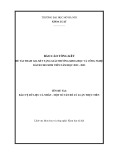
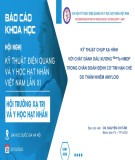

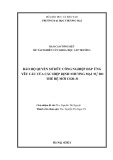
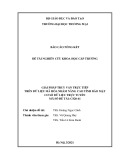
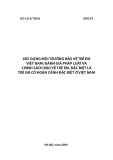

![Vaccine và ứng dụng: Bài tiểu luận [chuẩn SEO]](https://cdn.tailieu.vn/images/document/thumbnail/2016/20160519/3008140018/135x160/652005293.jpg)
